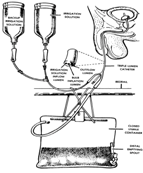Section I. ANATOMY AND PHYSIOLOGY
1-1. DIGESTION
a. The intake of food is necessary for life because
the foods we eat provide essential nutrients. Nutrients are substances
necessary for growth and repair of tissue and for maintenance of
normal body functioning. A "nutritionally adequate" diet will contain
all the essential nutritive substances in the amounts and proportions
required to maintain life and health. These essential nutrients are
carbohydrates, proteins, fats, minerals, vitamins, and water.
(1) Carbohydrates, proteins, and fats are the basic
fuels for cellular activity.
(2) Minerals are inorganic substances that help to
regulate body processes. Some work with the enzymes, some act as
catalysts, and some work within the buffer systems.
(3) Vitamins are organic nutrients that function to
regulate physiological processes such as growth and metabolism.
(4) Water is an important nutrient with many
functions. It acts as a coolant, a lubricant, a suspending medium,
and as a reactant in chemical processes.
b. Since the food we eat cannot be used for fuel in
its consumed form, it must be broken down (digested) to the molecular
level. In molecular form, the chemicals can be transported and
absorbed through the cell membranes for utilization by the body cells.
This process of digestion consists of both mechanical breakdown and
chemical breakdown.
(1) Mechanical digestion includes chewing,
swallowing, peristalsis, and defecation.
(2) Chemical digestion is the enzymatic breakdown of
the food- stuffs into chemically simple molecules that can be
absorbed and utilized by the cells.
c. Carbohydrates, also known as sugars and starches, are organic
compounds that provide the most ready source of energy to the body.
Carbohydrates are broken down to their simplest form, called a
monosaccharide, to be absorbed from the digestive tract. Carbohydrates
consist of three major groups: monosaccharides, disaccharides, and
polysaccharides.
(1) Monosaccharides are called the "simple sugars"
because they cannot be further broken down into simpler molecules.
The monosaccharide glucose is the major carbohydrate used for fuel
by the cells.
(2) Disaccharides are two monosaccharides that are
joined chemically.
(3) Polysaccharides are a group of five or more
monosaccharides that are joined chemically.
d. Proteins are complex molecules of chemically linked
chains of amino acids. Proteins are essential components of all cells
in the body and have many functions within the human body. Some
proteins function as enzymes, some as antibodies, and some are used
for nutrition. The diet must contain sufficient protein to replace the
protein broken down during normal body functions and growth. Proteins
are broken down into their constituent amino acids to be absorbed from
the digestive tract. These amino acids are transported to the body's
cells, where they are recombined to form (synthesize) new protein
molecules.
(1) All proteins are synthesized from combinations
of the naturally occurring amino acids. A great variety of proteins
are made possible with only a limited number of amino acids because
a different protein is created with each variation in the number and
arrangement of the amino acids. This can be likened to the alphabet
and words. The letters (amino acids) can be combined in a multitude
of ways to form different words (proteins).
(2) Ten of these amino acids are termed "essential"
amino acids. This is due to the fact that these amino acids cannot
be synthesized within the body, but must be consumed as food
for growth and survival. Other amino acids can be synthesized within
the body from other molecules present within the cells. A food
protein that contains all the essential amino acids is referred to
as a "complete" protein.
e. Fat is primarily an energy source. In addition to
its value as an energy source, fat serves as a carrier for the
fat-soluble vitamins (A, D, E, and K) and adds flavor to the diet.
Fats are emulsified in the intestine and split into fatty acids and
glycerol for absorption. If not used as immediate energy sources,
fatty acids are re-synthesized into body fat and stored in the many
fat cells of the body for future use.
1-2. METABOLISM
Metabolism refers to all the chemical activity within the body. All
chemical reactions either release or require energy. Metabolism has
two phases: an energy-generating process called catabolism and an
energy-requiring process called anabolism. Both processes occur
simultaneously within the cells, but they are regulated independently.
For this reason, the body's metabolism can be thought of as energy
balancing.
a. Catabolism is a degenerative, energy-generating
process. Complex molecules of proteins, carbohydrates, and fats are
systematically broken down into simpler, smaller molecules by the
body's cells. The bonding energies that hold the atoms of a complex
molecule together are released as the molecule is broken down. Much of
this energy released by catabolism is captured and stored by the cells
in the form of a chemical molecule known as ATP. Digestion is a
catabolic process because the breakdown of the food releases energy.
b. Anabolism is a building, energy-requiring process. New, more
complex molecules are synthesized from simple molecules. These larger
molecules form the body's structural and functional components. This
synthesis requires the expenditure of the cellular energy generated by
the cell's catabolic activities.
From
Nursing Care Related to the Gastrointestinal and Urinary Systems


